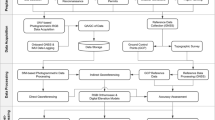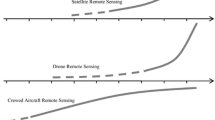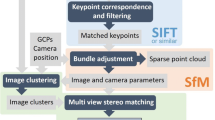Abstract
Investigating areas geologically prone to landslides is essential in all construction projects, especially roads. The importance of this issue even doubles if the area in question includes multiple landslide cases. Various factors are effective in the occurrence of landslides, including geological and lithological factors, soil thickness and texture, loose rocks, vegetation cover percentage, topography, slope amount, weather, and groundwater. In this research, a landslide study is conducted based on drone observations and numerical modeling to specify the important slopes prone to landslides. Two unmanned aerial vehicles (UAVs) equipped with cameras and sensors, along with a set of high-resolution images, were used to identify and assess the surface of landslide-prone areas. First, digital surface models were prepared based on the amount of slopes, surface features of the land, the topographical profiles, and a three-dimensional (3D) model of the area with the help of drone data. Then, the geological characteristics of the area were investigated using the borehole data. After physical and analytical modeling of slope failure, these data were interpreted using specialized software packages: (1) Rocscience SLIDE for numerical analysis by limit equilibrium method and (2) and (3) PIX4Dmapper and Agisoft Photoscan for 3D modeling. Eventually, the prone areas and sliding mechanism were identified using the analytical models. The results revealed the high accuracy and ability of the proposed method in 3D and numerical modeling of landslides. Overall, this method allows for determining the landslide’s dynamics, expansion, and surface.















Similar content being viewed by others
Data availability
The data that support the findings of this study are available from the corresponding author upon reasonable request.
References
Akca D (2013) Photogrammetric monitoring of an artificially generated shallow landslide. Photogram Rec 28(142):178–195. https://doi.org/10.1111/phor.12016
Aqeel M (2009) Investigating geomorphological instability of Sain pass (between Nair and Sarab cities, Azerbaijan region) using Anbalagan method. Geogr Environ Plann 37(1):77–94 (In Persian)
Bell R, Petschko H, Röhrs M, Dix A (2012) Assessment of landslide age, landslide persistence and human impact using airborne laser scanning digital terrain models. Geogr Ann A Phys Geogr 94(1):135–156. https://doi.org/10.1111/j.1468-0459.2012.00454.x
Bendea H, Boccardo P, Dequal S, Giulio Tonolo F, Marenchino D, Piras M (2008) Low cost UAV for post-disaster assessment. Int Arch Photogramm Remote Sens Spat Inf Sci 37(B8):1373–1379
Candan L, Kaçar E (2023) Methodology of real-time 3D point cloud mapping with UAV lidar. Int J Eng Geosci 8(3):301–309. https://doi.org/10.26833/ijeg.1178260
Chen Z, Song D, Hu C, Ke Y (2020) The September 16, 2017, Linjiabang landslide in Wanyuan County, China: preliminary investigation and emergency mitigation. Landslides 17:191–204. https://doi.org/10.1007/s10346-019-01309-1
Chen Z, Song D, Dong L (2021a) Characteristics and emergency mitigation of the 2018 Laochang landslide in Tianquan County, Sichuan Province, China. Sci Rep 11(1):1–16. https://doi.org/10.1038/s41598-021-81337-x
Chen Z, Zhou H, Ye F, Liu B, Fu W (2021b) The characteristics, induced factors, and formation mechanism of the 2018 Baige landslide in Jinsha River, Southwest China. CATENA 203:105337. https://doi.org/10.1016/j.catena.2021.105337
Chen Z, Song D, Du Y, Dong L (2023) Investigation on the spatial distribution of landslides in Sichuan Province, Southwest China. Geomatics Nat Hazards Risk 14(1):2232085. https://doi.org/10.1080/19475705.2023.2232085
Chou T, Yeh M, Chen YC, Chen YH (2010) Disaster monitoring and management by the unmanned aerial vehicle technology. In: Wagner W, Székely B (eds). ISPRS TC VII Symposium – 100 Years ISPRS. Vienna: International Archives of the Photogrammetry, Remote Sensing and Spatial Information Sciences, pp 137–142
Crété-Roffet F, Dolmiere T, Ladret P, Nicolas M (2007) The blur effect: perception and estimation with a new no-reference perceptual blur metric. In SPIE Electronic Imaging Symposium Conf Human Vision and Electronic Imaging (San Jose, CA) 6492–6516
Everaerts J (2005) PEGASUS—Bridging the gap between airborne and spaceborne remote sensing. New Strategies For European Remote Sensing 395–401. available at: https://www.google.com/url?sa=t&rct=j&q=&esrc=s&source=web&cd=&ved=2ahUKEwjSyazdkY6CAxV0TKQEHUI1C6MQFnoECBUQAQ&url=http%3A%2F%2Fwww.earsel.org%2Fsymposia%2F2004-symposium-Dubrovnik%2Fpdf%2F470.pdf&usg=AOvVaw0C9DPGOWY6g832nrCE7K54&opi=89978449
Fatemi SB, Rezaei Y (2010) Fundamentals of remote sensing, 3rd edn. Azadeh Press, Tehran
Godone D, Allasia P, Borrelli L, Gullà G (2020) UAV and structure from motion approach to monitor the Maierato landslide evolution. Remote Sens 12(6):1039. https://doi.org/10.3390/rs12061039
Hafizi MK, Abbassi B, Ashtari Talkhestani A (2010) Safety assessment of landslides by electrical tomography: a case study from Ardabil, Northwestern Iran. J Earth Space Phys 36(1):17–28
Hashemi Tabatabai S (2005) Preliminary report of the landslide of the Nair-Sarab communication axis. Geotechnical Department, Building and Housing Research Center, Ardabil, Iran, in Persian
Immerzeel WW, Kraaijenbrink PDA, Shea JM, Shrestha AB, Pellicciotti F, Bierkens MFP, de Jong SM (2014) High-resolution monitoring of himalayan glacier dynamics using unmanned aerial vehicles. Remote Sens Environ 150:93–103. https://doi.org/10.1016/j.rse.2014.04.025
Joint bulletin of weather and regional water company of Ardabil province, Statistics & information, Regional Water Company of Ardabil Province (2016) http://www.arrw.ir/st/412. Accessed 16 Nov 2023
Kottek M, Grieser J, Beck C, Rudolf B, Rubel F (2006) World map of the Köppen-Geiger climate classification updated. Meteorol Z 15:259–263. https://doi.org/10.1127/0941-2948/2006/0130
Lucieer A, de Jong SM, Turner D (2014) Mapping landslide displacements using structure from Motion (SfM) and image correlation of multi-temporal UAV photography. Prog Phys Geogr: Earth Environ 38(1):97–116. https://doi.org/10.1177/0309133313515293
Maraş EE, Nasery MN (2023) Investigating the length, area and volume measurement accuracy of UAV-Based oblique photogrammetry models produced with and without ground control points. Int J Eng Geosci 8(1):32–51. https://doi.org/10.26833/ijeg.1017176
Martha TR, Kerle N, Jetten V, van Westen CJ, Vinodkumar K (2010) Landslide volumetric analysis using Cartosat-1-derived DEMs. IEEE Geosci Remote Sens Lett 7(3):582–586. https://doi.org/10.1109/LGRS.2010.2041895
Mousavi SZ, Darvishzadeh A, Ghalamghash J, Vosoughi Abedini M (2014) Volcanology and geochronology of Sabalan volcano, the highest stratovolcano in Azerbaijan region, NW Iran. Nautilus 128(3):85–98
Nebiker S, Annen A, Scherrer M, Oesch D (2008) A lightweight multispectral sensor for micro UAV—Opportunities for very high resolution airborne remote sensing. Int Arch Photogramm Remote Sens Spat Inf Sci 37(B1):1193–1200
Niethammer U, Rothmund S, James MR, Travelletti J, Joswig M (2010) UAV-based remote sensing of landslides. Int Arch Photogramm Remote Sens Spat Inf Sci 38:496–501
Niyomukiza JB, Eisazadeh A, Tangtermsirikul S (2023) Recent advances in slope stabilization using porous vegetation concrete in landslide-prone regions: a review. J Building Eng 76:107129. https://doi.org/10.1016/j.jobe.2023.107129
Pedram H (1994) A comment on Iran’s landslides, their causes and distribution. 1st Seminar on Landslide and Their Hazard Reduction in Iran. By international institute of earthquake engineering and seismology, Tehran, Iran, in Persian
Rajaei MR, Asghari Moghaddam A (2001) Hydrogeochemistry and geometry of mineral water and hot water springs in the southeast slope of Sabalan (Sareyin and Bushli). Proceedings of the 5th Conference of the Geological Society of Iran. Tehran. In Persian
Road Traffic Consulting Engineers (2005) Report on excavation operations and soil mechanics studies in Sa’in drift area (Nir-Sarab axis). General Administration of Road and Transport of Ardabil Province, Ardabil, Iran, in Persian
Şasi A, Yakar M (2017) Photogrammetrıc modellıng of Sakahane Masjıd usıng an unmanned aerıal vehıcle. Turkish J Eng 1(2):82–87. https://doi.org/10.31127/Tuje.316675
Şasi A, Yakar M (2018) Photogrammetric modelling of Hasbey Dar’ülhuffaz (Masjid) using an unmanned aerial vehicle. Int J Eng Geosci 3(1):6–11. https://doi.org/10.26833/ijeg.328919
Sattarzadeh Y, Qeetanchi M, Mohammadi A (2010) Significant seismic activity in the Sareyin region, located in the southwest of Sabalan volcano. In: Proceedings of the fifth conference of the Geological Society of Iran
Seismological bulletin and catalog of earthquakes in Iran, International Research Institute of Seismology and Earthquake Engineering (2013) http://www.iiees.ac.ir/fa/insn/1388-04-03-08-31-28/. Accessed 16 Nov 2023
Shahidi F, Shoaei G, Mohammadi Vavsari M (2015) Investigation on the mechanism of Saein Strait landslide (Nir-Sarab Road) in regard to the hydrological and geomorphological conditions. Sci Q J Iran Assoc Eng Geol 8(1):13–33
Talebi A, Motavalli A (2016) Investigating natural landslides and roadside by using shallow landsliding stability physically based model (case study: Sari-Kiasar axis range). Iran J Geol 37(37):1
Teo TA, Fu YJ, Li KW, Weng MC, Yang CM (2023) Comparison between image- and surface-derived displacement fields for landslide monitoring using an unmanned aerial vehicle. Int J Appl Earth Obs Geoinf 116:103164. https://doi.org/10.1016/j.jag.2022.103164
Turner D, Lucieer A, Wallace L (2014) Direct georeferencing of ultrahigh-resolution UAV imagery. IEEE Trans Geosci Remote Sens 52(5):2738–2745. https://doi.org/10.1109/TGRS.2013.2265295
Ulvi A (2020) Importance of unmanned aerial vehicles (UAVs) in the documentation of cultural heritage. Turkish J Eng 4(3):104–112. https://doi.org/10.3316/informit.355573009146683
Westoby MJ, Brasington J, Glasser NF, Hambrey MJ, Reynolds JM (2012) Structure-from-motion’ photogrammetry: a low-cost, effective tool for geoscience applications. Geomorphology 179:300–314. https://doi.org/10.1016/j.geomorph.2012.08.021
Zhang Y, Chen G, Zheng L, Li Y, Zhuang X (2013) Effects of geometries on three-dimensional slope stability. Can Geotech J 50(3):233–249. https://doi.org/10.1139/cgj-2012-0279
Funding
No funding was received for conducting this study.
Author information
Authors and Affiliations
Contributions
Touraj S. Soleimani: Data acquisition, Investigation, Methodology, Software, Field observation, Writing Tohid Nouri: Supervision, Writing, Review & Editing, Reviewing, Methodology, Software Alireza Negahdar: Supervision
Corresponding author
Ethics declarations
Competing interests
The authors declare no competing interests.
Additional information
Communicated by: R. Ahmed
Publisher’s Note
Springer Nature remains neutral with regard to jurisdictional claims in published maps and institutional affiliations.
Rights and permissions
Springer Nature or its licensor (e.g. a society or other partner) holds exclusive rights to this article under a publishing agreement with the author(s) or other rightsholder(s); author self-archiving of the accepted manuscript version of this article is solely governed by the terms of such publishing agreement and applicable law.
About this article
Cite this article
Soleimani, T.S., Nouri, T. & Negahdar, A. Feasibility of using UAV in surveying and 3D modeling of landslides (case study of Ardabil province). Earth Sci Inform 17, 99–116 (2024). https://doi.org/10.1007/s12145-023-01147-9
Received:
Accepted:
Published:
Issue Date:
DOI: https://doi.org/10.1007/s12145-023-01147-9




